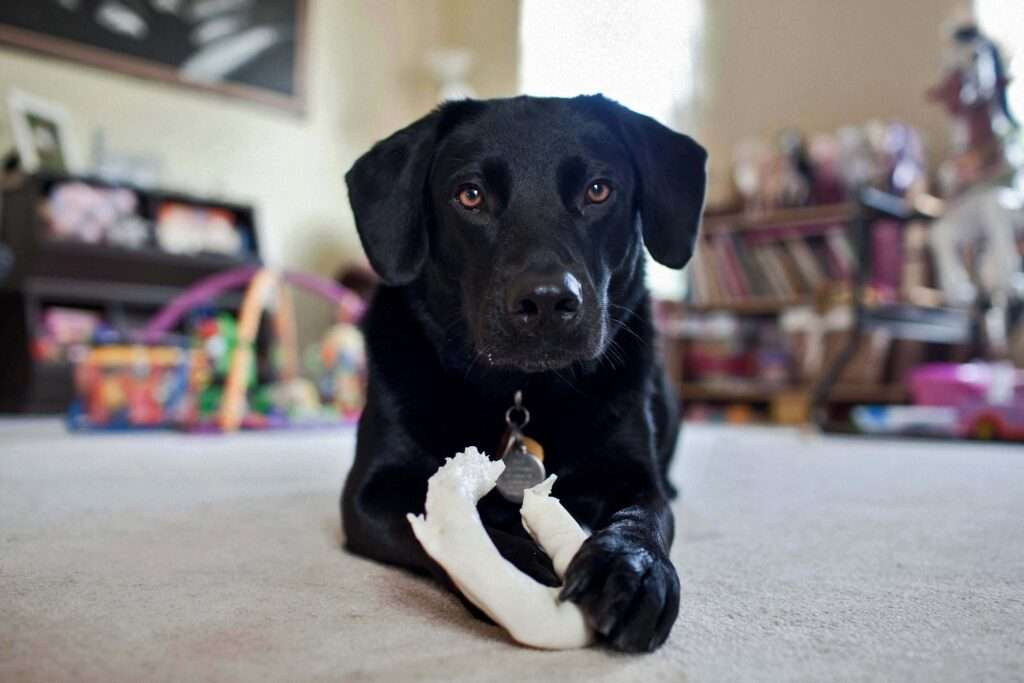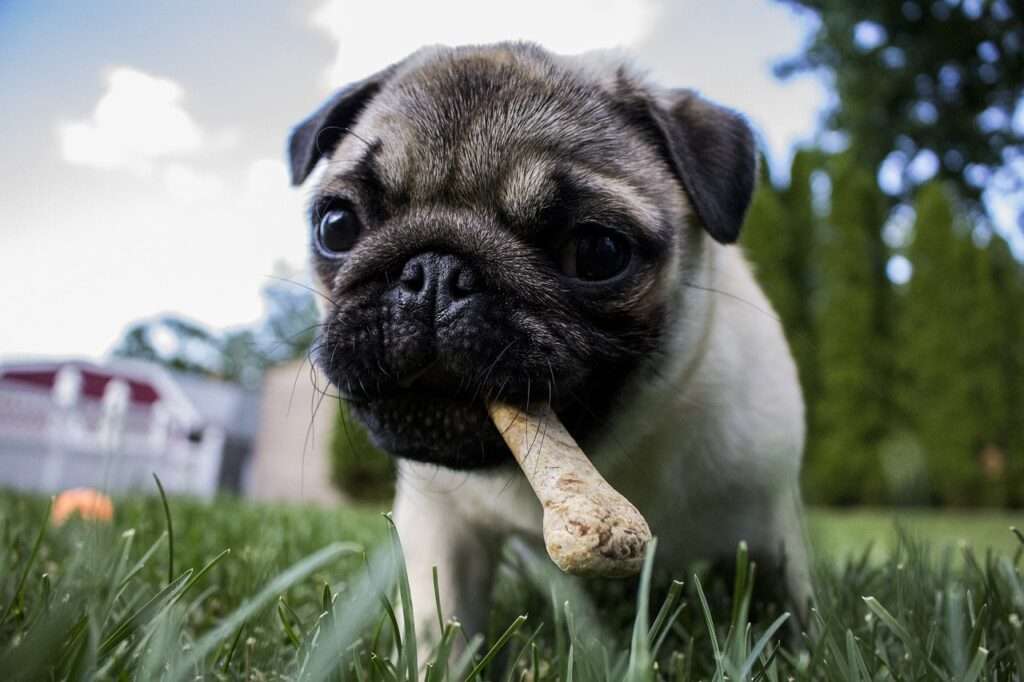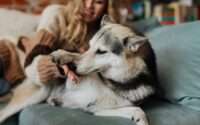Why Do Dogs Chew on Bones? The Science Behind this Peculiar Behavior
Picture this: a dog, happily gnawing on a bone, its tail wagging with pure delight. As pet owners, we often find ourselves captivated by this age-old canine behavior. But have you ever wondered why do dogs chew on bones? In this article, we embark on a journey to unravel the mystery behind this instinctual behavior that has been ingrained in our furry friends for centuries.
At BarkLikeMeow, we understand that dogs are more than just pets—they are beloved members of our families. That’s why we strive to provide you with comprehensive insights into your dog’s behavior and needs. Join us as we delve into the fascinating world of why dogs chew on bones, exploring the various angles that shed light on this fascinating behavior.
An Evolutionary Perspective of Canine Chewing Instinct

To truly understand why dogs chew on bones, we must travel back in time to their wild ancestors—the wolves. Dogs, as descendants of wolves, carry within them the remnants of their ancient heritage. In the wild, chewing played a vital role in survival, serving both practical and instinctual purposes.
Wolves, just like our modern-day dogs, relied on their powerful jaws and sharp teeth for hunting and tearing apart prey. Chewing allowed them to access vital nutrients from the bones and marrow, while also providing a means of exercising their jaw muscles.
Over time, as dogs were domesticated and selectively bred for various purposes, their chewing instincts remained intact. While our canine companions may no longer rely on hunting for survival, the instinct to chew persists, deeply rooted in their DNA.
Physical and Psychological Benefits of Chewing
Just like humans, dogs have physical and psychological needs that must be met for their overall well-being. Chewing on bones offers a multitude of benefits that contribute to their health and happiness.
Maintaining dental health and promoting good oral hygiene is one of the key advantages of chewing. The gnawing action helps remove plaque and tartar buildup, reducing the risk of dental diseases such as gum inflammation and tooth decay. Additionally, chewing stimulates saliva production, which aids in natural cleansing and can contribute to fresher breath.
But the benefits go beyond dental care. Chewing serves as a fantastic workout for your dog’s jaw muscles, helping to strengthen them and preventing jaw-related issues. It’s an excellent form of exercise, especially for dogs who may have limited opportunities for physical activity due to age, health conditions, or environmental constraints.
Moreover, chewing provides mental stimulation and acts as a stress relief for our canine companions. It allows them to channel their energy and focus their attention, providing a healthy outlet for their natural instincts. When dogs chew on bones, it can help alleviate boredom, reduce anxiety, and prevent destructive behaviors that may arise from pent-up energy.
Understanding Different Types of Bones
Raw bones and cooked bones each have their pros and cons. Raw bones, such as raw beef or bison bones, are often recommended by experts due to their softer texture and higher moisture content. They can provide a satisfying chewing experience and are less likely to splinter. However, caution should be exercised to ensure that raw bones are fresh and sourced from reputable sources, as they can harbor harmful bacteria.
On the other hand, cooked bones, including those leftover from your own meals, should be avoided. Cooking alters the structure of the bone, making it more prone to splintering. These splinters can pose a choking hazard or cause internal injuries when ingested. It’s essential to prioritize the safety of your dog and steer clear of cooked bones altogether.
When it comes to bone choices, you have options. Edible bones, such as rawhide or dental chews, are designed to be consumed and digested. They can offer a satisfying chewing experience while also providing additional dental benefits. Recreational bones, like beef knucklebones or marrow bones, are meant for gnawing and can be reused multiple times. These larger, weight-bearing bones can provide extended chewing sessions and keep your dog engaged.
Potential Risks and Precautions
When it comes to allowing your dog to chew on bones, safety should always be the top priority. While bones can provide numerous benefits, it’s essential to be aware of the potential risks and take necessary precautions.
Choking hazards are a primary concern when selecting bones for your dog. It’s crucial to choose bones that are appropriate for your dog’s size and chewing style. Avoid small bones that can be easily swallowed or become lodged in their throat. Opt for larger bones that encourage gnawing rather than gulping.
Splintering is another risk to be mindful of. Some bones, particularly cooked bones or those that are excessively dry or brittle, have a higher tendency to splinter. These sharp fragments can cause injuries to your dog’s mouth, throat, or digestive tract if swallowed. To mitigate this risk, choose bones that are less likely to splinter, such as raw bones or specially designed recreational bones.
Supervision is key when it comes to bone chewing. Always monitor your dog while they enjoy their bone to ensure they are chewing safely. Regularly check the bone for any signs of wear or deterioration, and replace it if necessary. Additionally, limit the duration of chewing sessions to prevent overconsumption or excessive wear on their teeth.
Signs of Excessive Chewing and Behavioral Issues
While chewing is a natural behavior for dogs, excessive chewing or destructive chewing can indicate underlying issues that need to be addressed. It’s essential to be aware of the signs and understand how to manage and redirect this behavior.
Excessive chewing can be a result of various factors, including anxiety, boredom, or insufficient exercise. If your dog is consistently chewing on objects other than their designated bones, it may be a sign of underlying stress or lack of mental stimulation. Additionally, certain medical conditions or dental problems can lead to increased chewing as a means of alleviating discomfort.
To address excessive chewing, it’s important to identify the root cause. Providing adequate exercise and mental stimulation through activities like daily walks, interactive toys, and training sessions can help redirect your dog’s chewing behavior. Ensuring your dog has access to appropriate chewing options, such as bones and chew toys, can also provide an outlet for their natural instincts.
If excessive chewing persists despite your efforts, it’s advisable to consult with a veterinarian or professional dog trainer. They can assess your dog’s behavior, rule out any underlying medical issues, and provide guidance on behavior modification techniques tailored to your dog’s specific needs.
Alternatives to Bones: Chews, Toys, and Treats
While bones are a popular choice for dogs to satisfy their chewing needs, there are plenty of alternative options available that can provide both mental stimulation and dental benefits. Offering a diverse range of chewing options is important to cater to different preferences and needs.
Chew toys are a fantastic alternative to bones, offering a variety of shapes, textures, and sizes to keep your dog engaged. From durable rubber toys to interactive puzzle toys, there is something for every canine companion. These toys can be filled with treats or peanut butter, adding an extra layer of enjoyment and mental challenge for your dog.
Dental chews and treats are specifically designed to promote good oral hygiene while satisfying your dog’s urge to chew. These treats often have a textured surface that helps remove plaque and tartar buildup, supporting dental health. It’s important to choose dental chews that are appropriately sized for your dog and made from safe and digestible ingredients.
Homemade and commercial chew options also offer a wide array of choices. Homemade options include frozen treats made from dog-safe ingredients, such as yogurt or mashed fruits, which can be soothing for teething puppies. Commercial chews, such as natural antlers or synthetic bones, provide long-lasting chewing satisfaction without the risks associated with real bones.
Remember, the key is to select chewing alternatives that are suitable for your dog’s size, age, and chewing strength. Always supervise your dog during chewing sessions and discard any toys or treats that show signs of wear or potential hazards.
Tailoring Chewing Solutions to Different Dog Breeds
For small and toy breeds, it’s important to consider their size and jaw structure. Opt for smaller-sized chews or toys that are designed specifically for small breeds. Soft, pliable toys or rubber chew toys can be great options for their delicate jaws. Ensure that the toys are free from small parts that could be choking hazards.
Medium and large breeds often have more chewing power and require sturdier options. Look for durable chew toys made from tough materials like nylon or rubber. Bones or recreational chews that are appropriately sized for their larger frames can provide longer-lasting chewing enjoyment.
Working and sporting breeds, known for their high energy levels, benefit from chews that offer a mental and physical challenge. Puzzle toys that require problem-solving skills or treat-dispensing toys that encourage active play can keep them mentally engaged while satisfying their chewing instincts.
Understanding your dog’s breed-specific needs and tendencies is crucial when selecting chewing alternatives. Consulting with breed-specific experts or trainers can provide valuable insights into the ideal chewing solutions for your beloved companion.
Nurturing Healthy Habits from the Start

Puppyhood is an exciting and joyful time, but it’s also a stage where chewing habits develop. Nurturing healthy chewing habits from the start is crucial to set your puppy up for a lifetime of positive behavior.
Puppies explore the world with their mouths, and chewing is a natural part of their development. It helps alleviate teething discomfort, aids in jaw muscle development, and satisfies their curiosity. However, it’s essential to guide their chewing behaviors towards appropriate outlets.
Provide a variety of puppy-safe chew toys that are specifically designed for teething puppies. Soft rubber toys or chilled teething rings can soothe their gums during the teething process. Avoid giving them old shoes or household items, as this may confuse them and lead to destructive chewing habits.
Supervision is crucial during this stage. Puppies may be prone to chewing on objects they shouldn’t, such as electrical cords or furniture. Redirect their attention to appropriate chew toys and reward them for chewing on those instead. This positive reinforcement helps them understand what is acceptable to chew on and what isn’t.
Consistency and patience are key when it comes to teaching puppies proper chewing behavior. If your puppy does engage in inappropriate chewing, calmly redirect them to a more suitable option without scolding or punishment. Remember, puppies are still learning, and positive reinforcement goes a long way in shaping their behavior.
Addressing Common Myths and Misconceptions
There are several myths and misconceptions surrounding dogs’ chewing behaviors that can cloud our understanding. At BarkLikeMeow, we believe in providing accurate information to debunk these myths and help you make informed decisions regarding your dog’s chewing habits.
Myth 1: All dogs can safely chew on any bone.
Reality: Different dogs have different chewing strengths and preferences. It’s important to select bones or chew toys that are appropriate for your dog’s size, age, and chewing style to prevent any potential risks.
Myth 2: Chewing on bones promotes aggressive behavior.
Reality: Chewing on bones is a natural behavior for dogs and does not directly correlate with aggression. However, it’s important to provide appropriate outlets for chewing and address any behavioral concerns through proper training and socialization.
Myth 3: All chew toys are safe for dogs.
Reality: Not all chew toys are created equal. It’s crucial to choose toys that are made from safe, non-toxic materials and are free from small parts that can pose choking hazards. Regularly inspect toys for signs of wear and replace them when necessary.
Myth 4: Dogs chew on bones to seek nutrition.
Reality: While dogs can derive some nutrients from chewing on bones, their primary motivation is often the natural instinct to chew and the enjoyment it brings. It’s important to provide a balanced diet that meets their nutritional needs.
By addressing these common myths and misconceptions, we can develop a better understanding of why dogs chew on bones and make informed choices for our furry friends.
The Role of Nutrition in Chewing Behavior
Proper nutrition plays a vital role in your dog’s overall health and can also impact their chewing behavior. A nutritionally complete and balanced diet provides essential nutrients that support your dog’s dental health and overall well-being. When dogs receive the necessary nutrients, their teeth and gums remain strong and healthy, reducing the likelihood of dental issues that may drive them to excessive chewing or seeking relief through inappropriate objects.
Certain nutrients, such as calcium and phosphorus, are particularly important for maintaining strong teeth and bones. High-quality dog foods formulated by reputable brands are designed to meet these nutritional requirements. It’s advisable to consult with your veterinarian to determine the best diet for your dog’s specific needs, taking into account factors such as age, breed, and any underlying health conditions.
In addition to a balanced diet, regular dental care is essential. Brushing your dog’s teeth and providing dental treats or toys can help remove plaque and tartar buildup, reducing the risk of dental diseases. Good oral hygiene can contribute to healthier teeth, making chewing on bones or appropriate chew toys a more enjoyable experience for your canine companion.
Remember, nutrition is a key component in supporting your dog’s chewing behavior and overall oral health. By providing a well-balanced diet and maintaining good dental hygiene, you can contribute to their overall well-being and foster positive chewing habits.
Conclusion
Chewing on bones is a natural behavior for dogs that offers numerous benefits for their physical and mental well-being. We have explored the reasons why dogs chew on bones, the physical and psychological benefits it provides, and the importance of selecting safe options.
From understanding the different types of bones and their suitability to addressing puppy chewing and tailoring solutions to different dog breeds, we have provided insights into fostering a healthy chewing routine for your beloved canine companion.
Do note that proper supervision, regular dental care, and providing a variety of chew toys and treats are crucial for nurturing healthy chewing habits. By meeting your dog’s chewing needs and redirecting their behavior to appropriate outlets, you can create a harmonious environment where they can thrive.
We hope this guide has equipped you with the knowledge and resources to enhance your understanding of why dogs chew on bones and how to create a positive chewing experience for your furry friend. Together, let’s celebrate the joy and benefits of chewing while ensuring the safety and well-being of our beloved canine companions.
Frequently Asked Questions
Why do dogs chew on bones?
Dogs have an innate instinct to chew, which helps them explore their environment, alleviate teething discomfort, strengthen their jaw muscles, and satisfy their natural urge. Chewing on bones also provides mental stimulation and can help keep their teeth clean.
Are all bones safe for dogs to chew on?
Not all bones are safe for dogs. It’s important to choose appropriate bones that are raw, uncooked, and size-appropriate for your dog. Avoid cooked bones, as they can splinter and cause injuries. Consult with your veterinarian for guidance on safe bone options.
Can chewing on bones lead to dental problems?
Chewing on bones can actually help maintain good dental health by removing plaque and tartar buildup. However, it’s essential to monitor your dog’s chewing habits and provide regular dental care, such as brushing their teeth and scheduling professional cleanings, to prevent dental issues.
What should I do if my dog chews on inappropriate objects?
If your dog engages in inappropriate chewing, redirect their attention to appropriate chew toys or bones. Positive reinforcement and consistent training can help them understand what is acceptable to chew on. It’s also important to puppy-proof your home and remove any tempting items from their reach.
Are there alternatives to bones for dogs to chew on?
Yes, there are plenty of safe alternatives to bones. You can provide chew toys made from durable materials like rubber or nylon. There are also dental chews, puzzle toys, and treat-dispensing toys that can keep your dog engaged and satisfied.
How can I address excessive chewing behavior in my dog?
Excessive chewing can be a sign of boredom, anxiety, or other underlying issues. Ensure that your dog is getting enough physical exercise and mental stimulation. If the behavior persists, consult with a veterinarian or a professional dog trainer to address any potential behavioral problems.
Can puppies chew on bones?
Puppies can chew on bones, but it’s crucial to provide appropriate options designed specifically for teething puppies. Soft rubber toys or chilled teething rings can help soothe their gums during the teething process. Avoid giving them bones until they have their adult teeth.
Remember, if you have any concerns or questions about your dog’s chewing behavior, it’s always best to consult with a veterinarian or a professional dog trainer for personalized advice.
References
- The Humane Society of the United States. (n.d.). Stop Your Dog’s Chewing. Retrieved from https://www.humanesociety.org/resources/stop-your-dogs-chewing
- Purina. (n.d.). Why Do Dogs Chew Everything? Retrieved from https://www.purina.com/articles/dog/behavior/why-do-dogs-chew-everything
- Bark. (n.d.). The Benefits of Chewing for Dogs. Retrieved from https://post.bark.co/health/dog-chewing-benefits/
- ASPCA. (n.d.). Destructive Chewing. Retrieved from https://www.aspca.org/pet-care/dog-care/common-dog-behavior-issues/destructive-chewing
- The Spruce Pets. (n.d.). Why Does My Dog Chew on Everything? Retrieved from https://www.thesprucepets.com/my-dog-chews-on-everything-4067895




